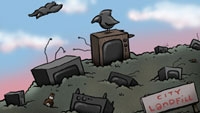Join the technology treadmill

In the last few months, the European Parliament has been debating a common approach to reaping the benefits of an analog switchoff (ASO), otherwise known as the digital dividend. With a high population density and predominately land borders, the member states have no alternative but to cooperate on the allocation of the spectrum that will be released. Common standards for services also lead to a larger market for consumer technology, which means lower prices and wider adoption of the new technologies. A typical example is mobile TV.
The parliament wants to foster public debate on the reuse of the freed spectrum. Television stations will not have an automatic right to their old analog UHF frequencies, with the telcom sector lobbying strongly for different applications. One proposal is for clusters of frequencies in sub-bands to cover the different applications, namely conventional terrestrial broadcasting, mobile TV and fixed/mobile broadband. With such a long history, the parliament considers the regulation of terrestrial broadcasting to be up to each state. However, the emerging technologies could well benefit from a pan-European approach.
What does it all mean for broadcast engineers? One only has to look at the standards development from the DVB Project. It means broadcasters must use more efficient codecs and modulation schemes. Current DTV transmissions use either MPEG-2 or AVC compression with a small mix of digital modulation: 2K/6K COFDM, DVB-T and DVB-T2. Each improvement inevitably leaves legacy receivers and STBs that cannot decode the latest standards.
The parliament notes that “spectrum policy has to be dynamic and that it should enable broadcasters to use future new technology.” For broadcasters, an upgrade could be just a software change to a digital modulator. However, for consumers, it means their STBs join their old analog receivers in a landfill. The confusion that ASO has created with some consumers must be balanced against the digital dividend. The shift from monochrome to composite color systems was backwards-compatible and used the same bandwidth. Future changes are not going to be the same.
The environmentalists are not going to like it, but the life of an STB is going to be much less than an old analog receiver. The same is true of the new integrated digital receivers. Many consumers are used to the rapid obsolescence of technology, from the cell phone to the PC. Upgrading technology brings many benefits such as improved picture quality and extra features. However, those who are not willing to participate in the treadmill of product replacement will ultimately be disenfranchised from the digital society.
Does it matter? It may to the elderly and disadvantaged. The European Parliament urges member states to take measures that enable the disabled, elderly and users with special social needs to make the most of the benefits provided by the digital dividend. However, it also notes that most member states are lagging behind other developed countries regarding investment in new-generation communication infrastructures.
As in many cases, governments must encourage investment and trade, but not at the expense of the weakest in society. Future developments in television will extend mobile to the masses and, when the business case permits, deliver 3-D to the home. Broadcast engineers can see the future. When will the viewers be willing to pay the social and monetary cost?
Get the TV Tech Newsletter
The professional video industry's #1 source for news, trends and product and tech information. Sign up below.
Send comments to:editor@broadcastengineeringworld.com
